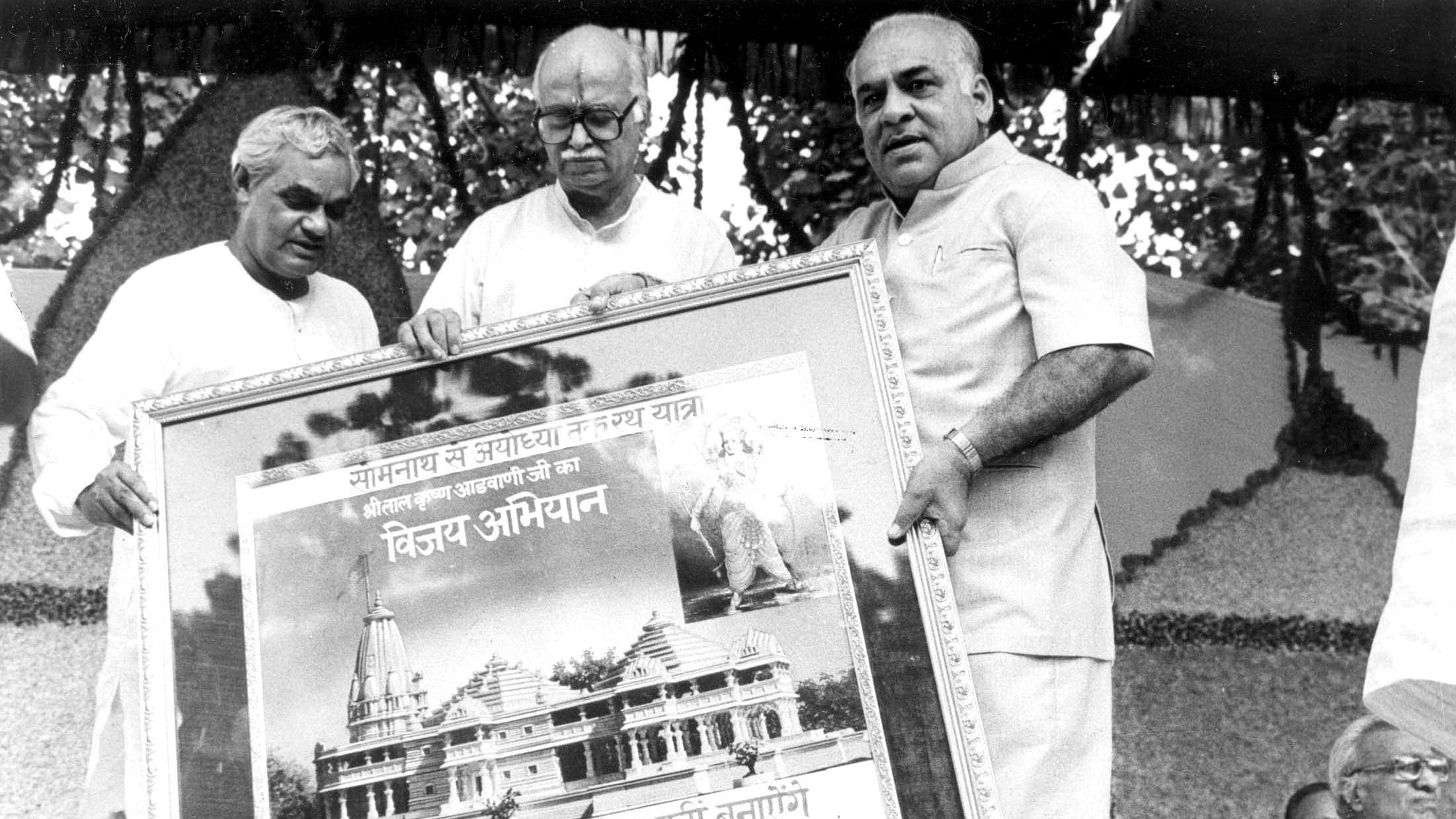
An archive picture of Atal Bihari Vajpayee and Madan Lal Khurana presenting a large painting of the proposed Ram Mandir at Ayodhya to L K Advani before his Rath Yatra from Somnath to Ayodhya, in New Delhi.
Credit: TPML archives
Prime Minister Narendra Modi consecrated Ram Lalla at the Ayodhya on Monday, marking an end to a decades-long conflict. While the Prime Minister has etched his name in the list of people instrumental in the realisation of the Ram mandir, here are a few other prominent figures that had a role to play in the journey.
Mahant Raghubar Das: One of the initiators of Ram mandir movement, Das filed a plea in the Faizabad district court seeking permission to build a canopy outside the structure in 1885.
Gopal Singh Visharad: The first plaintiff to file a suit in the Supreme Court seeking the right to worship at the main Janmabhoomi temple in 1950. He passed away in 1986.
Nirmohi Akhara: The Nirmohi Akhara represents a religious sect amongst the Hindus, that claimed that they were in charge of the structure at the disputed site which according to them was a ‘temple‘ until December 29, 1949. They filed a suit on December 17, 1959 for the “absolute right” in the management and charge of the temple. All 13 mahants of the akhara received an invitation for the consecration.
Also Read | Ayodhya Ram Mandir Timeline: Faith, Fervour, Furore
Ashok Singhal: One of the chief architects of the Ram Janmabhoomi movement, Singhal was the working president of Vishwa Hindu Parishad for over 20 years and organised a 'Dharam Sansad' during which the seeds for the campaign to demolish the 16th century Babri Masjid were sowed. He passed away in 2015.
L K Advani: The political face of the Ram Janmbhoomi movement, BJP veteran Advani mobilised volunteers for the movement during his ‘Rath Yatra’ from Somnath in Gujarat to Ayodhya that started on September 25, 1990.
Lalu Prasad Yadav: The former Bihar CM Lalu Prasad Yadav was one of the main reasons why Advani’s attempt to reach the Babri masjid site on October 30 was foiled after Yadav arrested the latter on October 23, that led to the BJP withdrawing its support for the V P Singh government. Rashtriya Janata Dal president Lalu Prasad Yadav was invited to the ceremony but declined the invitation on January 17.
Kalyan Singh: The chief minister of Uttar Pradesh during the Ram mandir demolition, Kalyan Singh found a prominent spot for himself in the report of the Liberhan Commission that read: "To sum up, December 6, 1992 saw a state of Uttar Pradesh unwilling and unable to uphold the majesty of the law. The ennui flowed from the very office of the Chief Minister (Kalyan Singh) downwards and infected the state's minions down till the bottom.” Kalyan Singh as the CM had given an undertaking to the apex court that no damage would be allowed to be inflicted to the disputed structure by the kar sevaks. Singh passed away in 2021.
Uma Bharti: Bharti had joined the BJP in her 20s but gained national prominence only during the Ram Janmabhoomi movement when she stood out as one of the main faces along with L K Advani and others. The Hindutva firebrand leader maintained that building a temple at the disputed site has been her “dream”. In the run-up to the temple concretion, Bharti attacked Congress and remarked that they did not deserve to go there.
Rajiv Gandhi: On November 9, 1989, Rajiv Gandhi had reportedly given permission to VHP to perform 'Shilanyas' (foundation stone laying ceremony) for the Ram temple ahead of the Rath Yatra. Kamal Nath in 2020 had said that the foundation of the temple had been laid by prime minister (late) Rajiv Gandhi "who had opened the Ram Janmabhoomi temple site in 1985". The former prime minister of India was assassinated in 1991.
Ranjan Gogoi: Appointed as the Chief Justice of India in 2018, Gogoi headed the bench that put an end to the century-long dispute around Ram Janambhoomi-Babri Masjid and cleared way for the construction of a Ram Temple at the disputed site. The BJP-led Assam government on January 17 had announced to bestow "Asom Baibhab," the state's highest civilian award upon former CJI Gogoi for his contribution in the judgement.
Murli Manohar Joshi: BJP president between 1991-1993, Joshi was an active member of the Ram Janmabhoomi movement. He, along with L K Advani delivered a speech on the day of the demolition that lakhs of people had gathered to hear. An FIR was filed against him on the same day soon after the demolition. Joshi also received an invitation for the consecration ceremony.
Atal Bihari Vajpayee: Former prime minister of India, Atal Bihari Vajpayee In October 2001 set up the Ayodhya cell to look into the dispute. While he had repeatedly asserted that he was not involved in the demolition, a speech by the leader on December 5, 1992, was filled with strong references of the dispute: “Sharp-edged boulders are present at the site. Nobody can sit there. The ground needs to be levelled. It has to be made fit for sitting. Some construction work can take place there as arrangements for a Yagnya has to be done.” Moreover, the Liberhan Commission report also found Vajpayee’s involvement in the dispute.
Baba Lal Das: Court appointed chief priest of the Ram Lalla idols inside the Babri Masjid of the Ayodhya dispute in India in 1981. He was vocally against the communal riots taking place in the country around the time of the Babri demolition. He was shot dead in November 1993.
P V Narasimha Rao: Rao was the Prime Minister of India when Babri masjid was demolished.